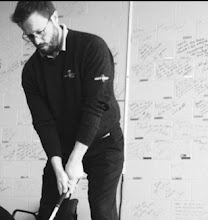Tuesday, 19 January 2010
Pre-shot Routine (Tip)
After making all of your pre-shot decisions – what shot to hit, how to swing and with what club – the next step is to focus on visualizing the look and feel of the perfect swing. The goal of this preparation process is to see and feel the exact swing you are going to make before you try to make it happen for real. One or two practice swings may or may not be enough. Your last practice swing should feel exactly right for the shot you want to hit. If it feels right, you are ready to go; if not, make another one, two, or three swings as necessary, until you are completely comfortable. When your mind’s eye says, “Yes, that’s the swing I want, that’s my ‘perfect preview swing’,” lock onto that image. With the look and feel of the perfect swing fresh in your mind and muscles, you are ready to move into your address position, start your pre-shot ritual (waggle) and hit the shot.
Tuesday, 12 January 2010
Statement of the week
Research has proven that golfers lose almost 80 percent of their shots to par inside of 100 yards from the hole. To that end, our golf school curriculum focuses strictly on what I define as “The Scoring Game,” a combination of the short game (distance wedges, pitching, chipping, sand play) and putting, which comprise 60 to 65 percent of the total number of shots played per round. From three-foot putts to full wedge and long bunker shots, at this truly unique golf school, you’ll learn to properly execute shots from any scoring position.
If you have difficulty controlling distance when you face short shots, it may be because you find a small, delicate swing with a short backswing to be a more difficult swing to make than a long backswing. Research shows this to be true for any level of player. One problem with the short backswing is that there is not much time to get your body parts synchronized. It is the same feeling you may have over very short putts: You jab with the hands because you feel there is not enough time to get the flow and rhythm of the stroke.
If you have difficulty controlling distance when you face short shots, it may be because you find a small, delicate swing with a short backswing to be a more difficult swing to make than a long backswing. Research shows this to be true for any level of player. One problem with the short backswing is that there is not much time to get your body parts synchronized. It is the same feeling you may have over very short putts: You jab with the hands because you feel there is not enough time to get the flow and rhythm of the stroke.
Subscribe to:
Comments (Atom)


















